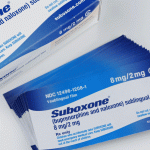
Over the past decade, Vicodin has become a household name. The number of prescriptions since 2006 has risen to over 131 million per year in the United States alone. It is frequently prescribed for severe pain, and like other opioid-based medications, it is highly addictive. It is a combination of acetaminophen (Tylenol) and hydrocodone (an opioid) and works on the brain in two ways. The acetaminophen works by lowering a chemical in the brain that stimulates pain nerves, and the hydrocodone binds to receptors in the brain and nervous system to stimulate positive feelings and reduce pain and anxiety. Often times, those who become dependent and addicted to Vicodin, usually start off with a legitimate prescription from a doctor, due to an injury or surgery of some kind. Vicodin users normally take the pill orally, however, as their dependence progresses, users may begin to crush and snort, or inject after being dissolved in water. Snorting or injecting the drug allows it to enter the bloodstream more rapidly and produces a more intense feeling of euphoria. Many people who abuse Vicodin turn to other opiates or heroin, or may mix Vicodin with stimulants. Combining depressants with stimulants is extremely dangerous and can lead to stroke or heart failure.
Because the body quickly adjusts to the higher levels of endorphins, suddenly eliminating the drug can lead to painful and even dangerous opioid withdrawal symptoms. Withdrawal symptoms start to happen soon after the drug is out of the bloodstream, about 8 hours for Vicodin. Withdrawal is never something that someone looks forward to, but understanding the process can make it less frightening. Vicodin withdrawal should never be something that you do alone, and should always be supervised by a medical professional. Patients that are prescribed Vicodin are always recommended to stop using the drug under a doctor’s supervision because of the side effects that may occur, even for those not struggling with addiction. Here are some of the effects of Vicodin withdrawal that a person may experience.
Initially, symptoms of Vicodin withdrawal may include:
- Irritability or mood swings
- Anxiety or confusion
- Hostility
- Intense cravings for Vicodin
- Loss of appetite
- Aches and pains
- Cold or flu-like symptoms such as fever, chills, and runny nose
- Sweating
These may be followed by more intense withdrawal symptoms such as:
- Abdominal cramping and or diarrhea
- Nausea and vomiting
- Trouble sleeping
- Fatigue or exhaustion
- Irregular heartbeat
Some patients may also experience PAWS (post-acute withdrawal syndrome), which can happen after weeks or even months after the initial withdrawal period. PAWS symptoms include mood swings, fatigue, and difficulty concentrating. Typically, withdrawal peaks for around 7-10 days, however, this can vary from person to person. Someone who has been addicted for several months and has a high tolerance level for the drug will experience longer withdrawal time than someone with a shorter addiction period. Factors that affect how long the withdrawal period may include:
- The length of addiction period. Studies have shown that the length of the withdrawal period is directly affected by the length of time that a person has been dependent on the drug.
- Withdrawal can last longer and be more severe for someone who has developed a tolerance and is able to take larger doses than the standard or recommended amount.
- Psychological factors. The more intense a person’s psychological addiction is, the longer the withdrawal period can be.
- Method of detox. A person that tries to detox on their own and without medication may experience a shorter, although much more intense withdrawal period.
Contact Clearbrook Today
Our Pennsylvania rehab maintains a 22-bed detoxification unit for our patients. During a detoxification program each patient is monitored for withdrawal symptoms and provided with medical assistance throughout the course of treatment. This time of detoxification can include uncomfortable, painful, and upsetting physical complications. As their organs expel toxic substances and return to a normal state, significant health issues can arise that may require sustained medical management. Medical and nursing care is provided around the clock.
If a patient is experiencing significant withdrawal symptoms, he or she will stay in this unit until Clearbrook’s physician provides approval for their release. Upon completion of the detoxification phase, the patient immediately enters our primary treatment program. Some may want to believe that removing the chemicals from their body is enough to recover, but that is simply not the case. Completion of detoxification from mood-altering chemical substances does not complete treatment for addiction. Patients must continue on to the primary treatment, so they can learn to cope with life stressors, emotions, and other underlying issues that may have been the central starting point for their addiction.
If you or someone you love is struggling with addiction, please contact our Admissions Specialists today. Addiction is a disease and should be treated as such. You don’t have to fight it alone!







